Geotextiles are permeable geosynthetic fabrics (textiles) that can separate, filter, reinforce, protect, or drain when used in conjunction with soil. As the use of geotextile fabrics has grown, so has the creation of geotextile composites and products like geogrids and meshes. Geotextiles and associated materials/products are the umbrella term for these materials. Roads, airfields, railroads, embankments, retaining structures, reservoirs, canals, dams, bank protection, and coastal engineering are among the many civil engineering applications where they are beneficially used.
Geotextiles are employed as an integral part of a human-made project, structure, or system with foundation soil, rock, earth, or any other geotechnical engineering-related material. AASHTO (M288-96) specifies geotextile strength standards in the United States of America. In Europe, EN 13249:2016 specifies the relevant characteristics of geotextiles and geotextile-related products used in the construction of roads and other trafficked areas (excluding railways and asphaltic inclusion), and the appropriate test methods to determine these characteristics. According to EN 13249:2016, the intended use of these geotextiles or geotextile-related products is to fulfill one or more of the following functions: filtration, separation, and reinforcement. The separation function will always occur in conjunction with filtration or reinforcement, and hence will not be specified alone.
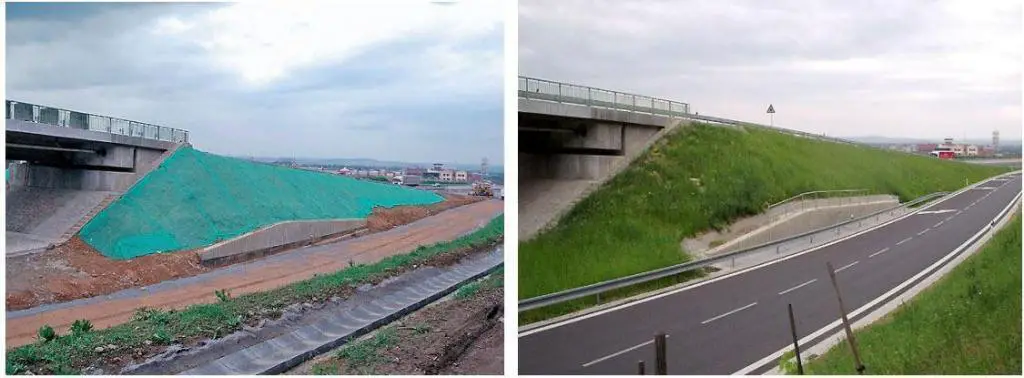
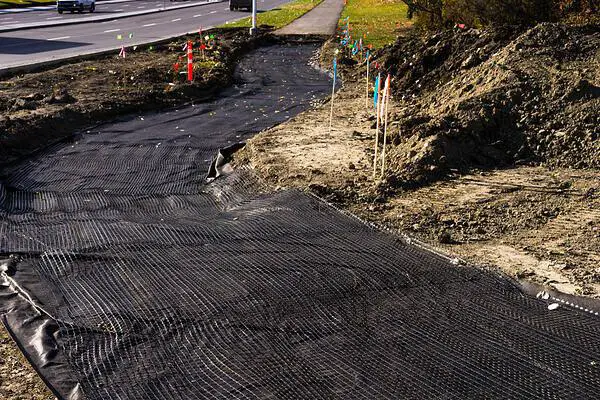
Geotextile tensile strength varies depending on the geotextile designation and the design requirements. A woven slitfilm polypropylene (weighing 240 g/m2), for example, has a strength range of 30 to 50 kN/m. The angle of friction between soil and geotextiles varies depending on the geotextile and the soil. For design purposes, it is usually necessary to apply reduction factors to the laboratory tensile strength of geotextiles in order to suit site conditions.
The different functions of geotextiles in soils are:
- Erosion protection
- Sealing
- Filtering
- Reinforcing
- Drainage
- Separation
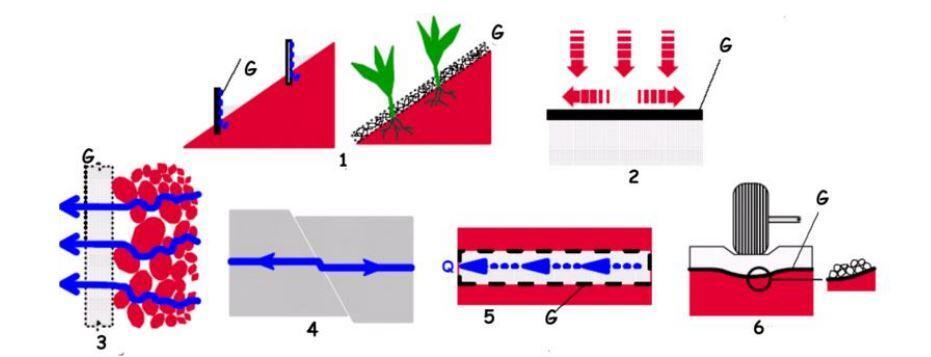
Geomembranes are impervious membranes that are frequently utilized as cut-offs and liners. Geomembranes were mostly utilized as canal and pond liners until recently; nevertheless, one of the most common current uses is the containment of hazardous or municipal wastes and their leachates. Geotextile or mesh underliners are used in many of these applications to support or protect the more flexible geomembrane while also functioning as an escape route for gases and leachates generated in specific wastes.
Construction of Reinforced Earth Structures using Geotextiles
Reinforced earth is a construction material made up of soil fill that has been strengthened by the addition of rods, bars, fibers, or nets that provide frictional resistance to the soil. The idea of using rods or fibers to reinforce soil is not new. Thin metal strips, geotextiles, and geogrids are currently used as reinforcing materials in the construction of reinforced earth retaining walls. The three components of a mechanically stabilised earth wall are the facing unit, the backfill, and the reinforcing material. Modular concrete blocks, currently called segmental retaining walls are most common as facing units.
The type of facing unit and reinforcing material employed in the system usually determine the process of constructing a mechanically stabilised earth wall. The skin, also known as the facing unit, can be flexible or rigid, but it must be robust enough to hold the backfill in place and allow fastenings for the reinforcement to be connected. The facing units only need a small foundation to be built on, which usually consists of a trench filled with mass concrete that provides a footing similar to that seen in domestic housing.
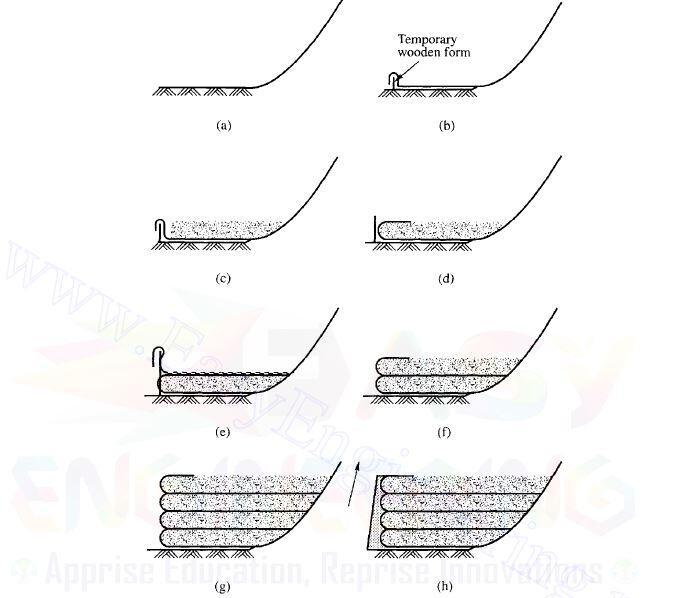
The construction procedure with the use of geotextiles is explained in Figure 4. Here, the geotextile serves both as a reinforcement and also as a facing unit. The procedure is described below as given by Murthy (2009) with reference to Figure 4.
- Start with an adequate working surface and staging area (Fig. 4(a)).
- Lay a geotextile sheet of proper width on the ground surface with 4 to 7 ft at the wall face draped over a temporary wooden form (b).
- Backfill over this sheet with soil. Granular soils or soils containing a maximum of 30% silt and /or 5% clay are customary (c).
- Construction equipment must work from the soil backfill and be kept off the unprotected geotextile. The spreading equipment should be a wide-tracked bulldozer that exerts little pressure against the ground on which it rests. Rolling equipment likewise should be relatively lightweight.
- When the first layer has been folded over the process should be repeated for the second layer with the temporary facing formwork being extended from the original ground surface or the wall being stepped back about 6 inches so that the form can be supported from the first layer. In the latter case, the support stakes must penetrate the fabric.
- This process is continued until the wall reaches its intended height.
- For protection against ultraviolet light and safety against vandalism, the faces of such walls must be protected. Both shotcrete and gunite have been used for this purpose.
Design Considerations for Mechanically Stabilised Earth Walls using Geotextiles
The design of a mechanically stabilised earth wall involves the following steps (Murthy, 2009):
- Check for internal stability, addressing reinforcement spacing and length.
- Check for external stability of the wall against overturning, sliding, and foundation failure.
The general considerations for the design are:
- Selection of backfill material: granular, freely draining material is normally specified. However, with the advent of geogrids, the use of cohesive soil is gaining ground.
- Backfill should be compacted with care in order to avoid damage to the reinforcing material.
- Rankine’s theory for the active state is assumed to be valid.
- The wall should be sufficiently flexible for the development of active conditions.
- Tension stresses are considered for the reinforcement outside the assumed failure zone.
- Wall failure will occur in one of three ways
a. tension in reinforcements
b. bearing capacity failure
c. sliding of the whole wall soil system. - Surcharges are allowed on the backfill. The surcharges may be permanent (such as a roadway) or temporary.
a. Temporary surcharges within the reinforcement zone will increase the lateral pressure on the facing unit which in turn increases the tension in the reinforcements but does not contribute to reinforcement stability.
b. Permanent surcharges within the reinforcement zone will increase the lateral pressure
and tension in the reinforcement and will contribute additional vertical pressure for the reinforcement friction.
c. Temporary or permanent surcharges outside the reinforcement zone contribute to lateral pressure which tends to overturn the wall. - The total length L of the reinforcement goes beyond the failure plane by a length Lg. Only length Lg (effective length) is considered for computing frictional resistance. The length LR lying within the failure zone will not contribute to frictional resistance
- For the purpose of design, the total length L remains the same for the entire height of wall H. Designers, however, may use their discretion to curtail the length at lower levels.
References
[1] Van Baars Stefan (2016): Advanced Soil Mechanics. Edited and published by Stefan Van Baars. Edition May 2016
[2] Murthy V. N. S. (2009): Textbook of Soil Mechanics and Foundation Engineering: Geotechnical Engineering series. CBS PUBLISHERS AND DISTRIBUTORS PVT LTD

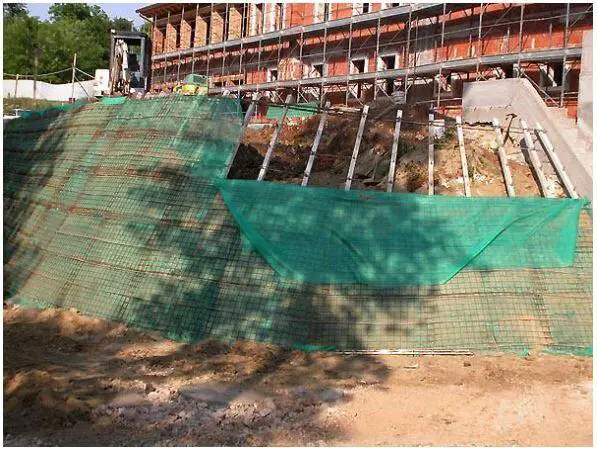









why is the length of textile after folding (the folded part) is smaller than the lower textile length? and how to calculate